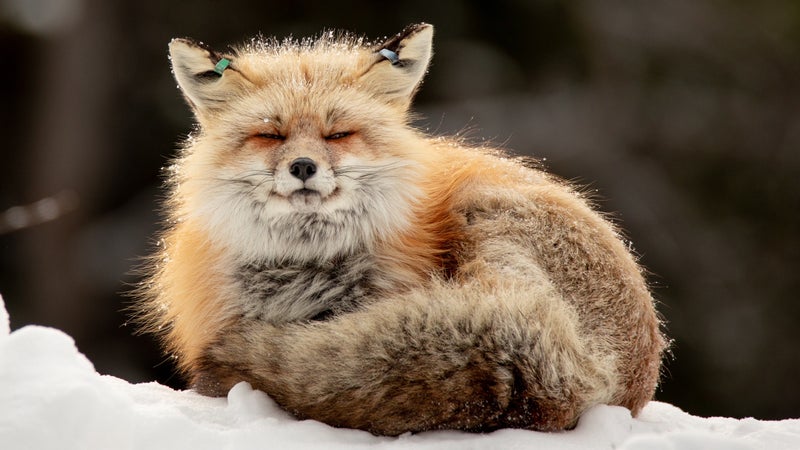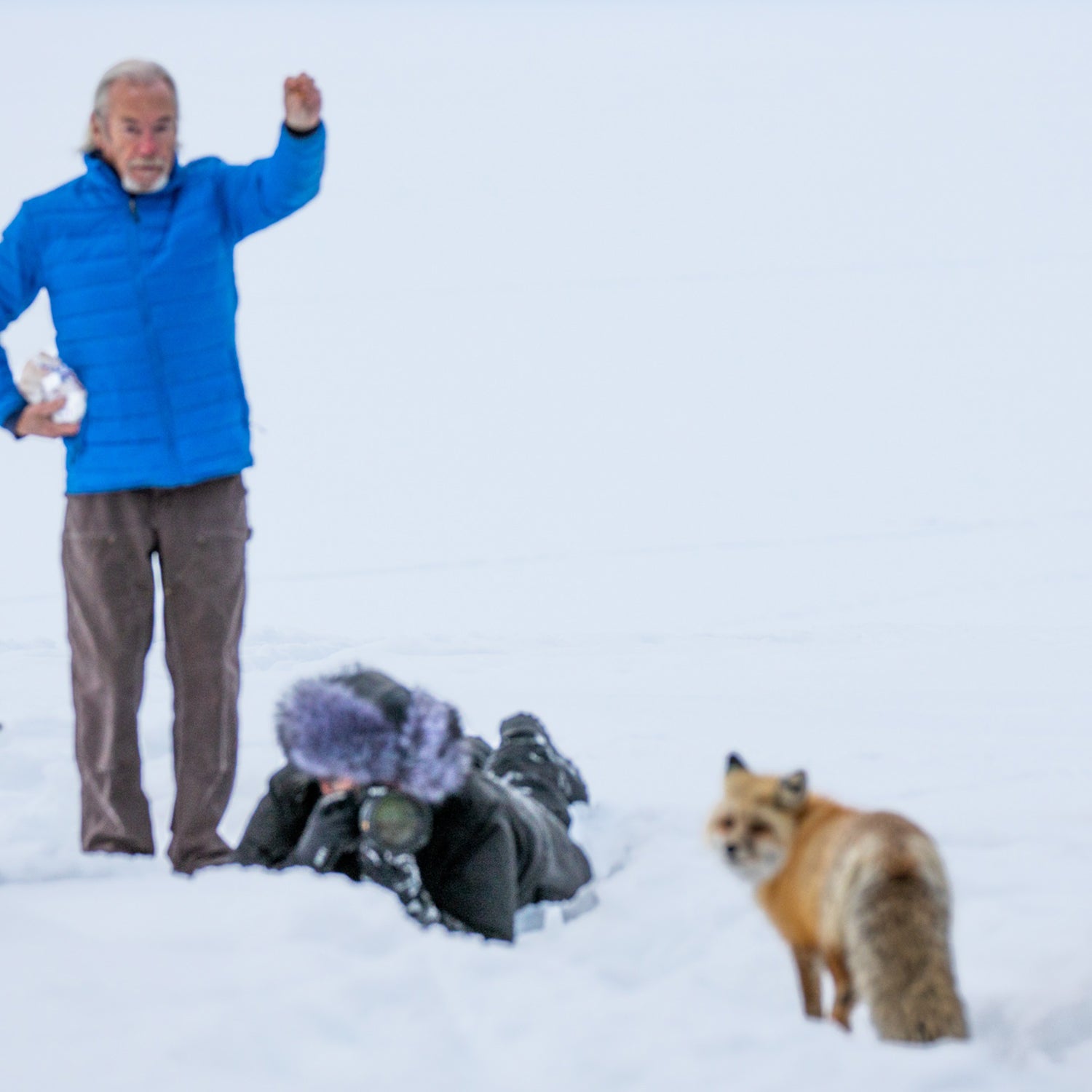World-renowned British photographer was lying on his stomach in the snow on a Tuesday in late January, his camera lens pointed at╠řa pair of red foxes padding toward him over a frozen lake╠řat ░┬▓Ô┤ă│żż▒▓ď▓ÁÔÇÖs╠řGrand Teton National Park. His╠řcolleague, Tom Rosenthal, stood behind, tempting and drawing the canines closer by waving a piece of cellophane wrapper from a pack of cigarettes that they might take for food.
The goal was to get a supertight shot of wild foxes, and the tacticÔÇöthough ethically dubiousÔÇöworked. After an , however, along with an eyewitness allegation that the crew had illegally fed the animals,╠řthe backlash was swift.╠ř
ÔÇťIf he was a tourist, I would understand,ÔÇŁ says Tiffany Taxis, the╠řphotographer in Jackson, Wyoming,╠řwho captured the scene and reported the incident to the National Park Service. ÔÇťBut David Yarrow knows what heÔÇÖs doing. He endangered the life of an animal so that he could get a good shot, and it really rubs me the wrong way.ÔÇŁ╠ř
Yarrow and Rosenthal╠řdefended their actions, saying that they didnÔÇÖt actually feed the foxes. ÔÇťI donÔÇÖt think they can eat cigarettes, do they?ÔÇŁ Rosenthal told me.
Two weeks later, park rangers trapped and killed one of the foxes that was present the day of YarrowÔÇÖs shoot. Because the animal was habituated and food driven, having spent the past year accosting picnickers and thieving anglersÔÇÖ trout, its fate had been sealed for monthsÔÇölong before YarrowÔÇÖs brush with it. Nevertheless, criticism of Yarrow, known for his highly stylized photographs of high fashion, historical scenes, and wildlife, continued.╠řA emerged calling for his total ban from all national parks, which╠řhas garnered more than 6,200 signatures.╠řThose on social media╠řwho pinned╠řthe foxesÔÇÖ fate╠řon Yarrow╠řreferenced his ╠řapproach to wildlife photography╠řin the past,╠řwith alleged reports of deploying animals from game farms and taking images that showed models in dangerously close proximity to African elephants.╠ř
Yarrow told me that the past outcries╠řhave prompted him to become more╠řintrospective, contrite, and make a concerted effort to model better behavior.╠řÔÇťI think in pursuit of creativity and authenticity, we should never push it so far that we get criticism,ÔÇŁ he says.╠řÔÇťHave I changed? Yes. We try to stay clear of anything that can be seen as remotely contentious.ÔÇŁ The photographer ÔÇťvehementlyÔÇŁ denies feeding the foxes.╠řÔÇťDid I exploit it for commercial gain? Absolutely not,ÔÇŁ Yarrow╠řsays.
Still, once╠řTaxisÔÇÖs photo of the crew made the rounds, there was outrage,╠řsays╠řDave Navratil, president of the╠ř. ÔÇťWe didnÔÇÖt have a whole lot of people telling each other to calm down,ÔÇŁ he says.
While NavratilÔÇÖs club didnÔÇÖt cast its own aspersions, members did use the incident to promote their ÔÇťShoot to CareÔÇŁ , which encourages photographers to keep a safe distance, refrain from approaching dens or adult females with their young, and model behavior that puts animal welfare first. But beyond these localized education efforts, there are few regulations governing wildlife photography in the U.S. While some national parks set viewing thresholds, such as maintaning a distance of╠ř100 yards from wolves and bears and 25 yards from other species, these measures can be difficult to enforce. Both within and beyond the parks, professional and hobby photographers are often left to their own judgement, which╠řsometimes means╠řprioritizing╠řthe╠řshot╠řover an animalÔÇÖs well-being.╠ř
ÔÇťItÔÇÖs all self-regulated,ÔÇŁ Navratil says. ÔÇťIt comes down to each person╠řand what theyÔÇÖre willing to do.ÔÇŁ
Wildlife crowding often╠řleads to╠řhabituation, which causes╠řaggressive, incautious, or destructive behavior that isnÔÇÖt tolerated by wildlife managers, as it puts both the animals and humans at risk. From╠ř breaking into cars and raiding campgrounds to an╠ř with moose or elk who have become accustomed to roads, such incidents have seen in recent years.╠řPhotographers donÔÇÖt deserve all the blameÔÇöanybody can approach an animal too closelyÔÇöbut the peripheral╠řand long-term nature of a photographerÔÇÖs presence╠řcan have a lasting impact on an animalÔÇÖs conditioning.╠ř

Yellowstone has dealt with human-conditioned wolves since the mid-nineties, shortly after the species was reintroduced, and the canines have proven a magnet for photographers whoÔÇÖve learned where to go to view packs.╠řIn 2019, word spread locally of a visible wolf den at YellowstoneÔÇÖs Slough Creek, exposing especially impressionable puppies to people. This contributed to a litter born to the Junction Butte pack that became . Two of the seven-month-old pups were hit and killed on roads that year, and another, known as 1273M, lost all apprehension around people; at one point, it╠řeven ran off with a tripod that had been propped up on the side of the road.╠ř
ÔÇťThe guy ran after the wolf, because it was an expensive tripod,ÔÇŁ says Doug Smith, a leader with Yellowstone Wolf Project, a program that oversees the parkÔÇÖs wolf research and monitoring initiatives. ÔÇťThe wolf dropped it, [the guy] picked it up and started bringing it back to the road, and the wolf followed him.ÔÇŁ╠ř
ThatÔÇÖs a problem. Twice before, Yellowstone wolves deemed hopelessly habituated have been put down. To avoid similar consequences with the Junction Butte pack, Smith and his colleagues took a page out of YellowstoneÔÇÖs 2003 plan for╠řhabituated wolf management,╠řwhich calls for hazing animals that venture near roads and people with nonlethal projectiles, like paintballs. When the parkÔÇÖs borders closed to visitors for 55 days at the start of the COVID-19 pandemic, SmithÔÇÖs╠řstaff went out ÔÇťarmed to the teethÔÇŁ with the intent to reverse wolf 1273MÔÇÖs conditioning.╠ř
ÔÇťTo put it bluntly, we pounded him last spring when the park was closed,ÔÇŁ Smith says. ÔÇťI mean╠řpounded him. A researcher hit him with bear spray. Any time he was on the road, we hit him with paintballs, beanbags, rubber bullets, the whole nine yards.ÔÇŁ The nonlethal projectiles had the desired effect:╠řkeeping wolf 1273M alive. Its last close brush with people occurred╠řwhen a raven researcher doused the canine with capsicum.╠ř
The relationship between photographers and habituated grizzly bears in the greater Yellowstone region has╠řalso been an issue. Since 2017, photographers have migrated at the start of summer to Togwotee Pass, on the east side of Jackson Hole, to see one especially well-known and human-conditioned grizzly bear, a female known as Felicia.
Ursine life alongside a 70-mile-per-hour╠řhighway╠řis╠řfraught. Yet the Wyoming Game and Fish Department has documented illegal placement of food and grain along the highway to keep the bears habituated to feeding along the road. Felicia roams amid╠řa national forest where thereÔÇÖs limited law enforcement, so photographers are generally left╠řto police themselves. They donÔÇÖt do a good job, though,╠řand have been criticized for getting dangerously close to animals.
Last May, photo-tour guide and local resident Jack Bayles came upon a cluster of professional wildlife photographers╠řpositioned off the highway, in the grass, 50 feet from Felicia. An agitated male grizzly lingered nearby that was chomping and snapping his jaws. ÔÇťI donÔÇÖt know why folks are so competitive to get the full-face shots that you just canÔÇÖt take ethically,ÔÇŁ says Bayles, who adds that if youÔÇÖre taking╠řclose-up shots of grizzlies without having to crop your photos, youÔÇÖre too close.╠ř
National-forest staffers who manage the land around Togwotee Pass donÔÇÖt have the capacity to╠řmonitor the remote highway every time a grizzly shows up, but they are╠řcurrently working with a local nonprofit, , to develop a volunteer corps that guarantees someone is always on-site╠řwearing official garb. ÔÇťWeÔÇÖre really in favor of those types of efforts,ÔÇŁ Bayles says, ÔÇťand weÔÇÖd like to see more of that.ÔÇŁ╠ř
ÔÇť║┌┴¤│ď╣¤═° of the parks, it largely falls on the photography community, which in todayÔÇÖs world usually means social media condemnation. This can be effective╠řbut has its own issues.ÔÇŁ
ItÔÇÖs one thing to try and╠ředucate casual visitors on how to behave around wildlife╠řand responsibly photograph it, says Navratil╠řof the╠řTeton Photography Club. ItÔÇÖs another to try and╠řmanage the behavior of professionals who should know better╠řbut push ethical boundaries to get the shot.╠řÔÇťInside a national park, you have rules that can be applied by the Park Service,ÔÇŁ Navratil says. ÔÇť║┌┴¤│ď╣¤═° of the parks, it largely falls on the photography community, which usually means social media condemnation. This can be effective╠řbut has its own issues.ÔÇŁ╠ř
People tend to forget reason and manners during online tongue-lashings. Plus, social media scorn also takes place after the factÔÇöwhen harm to the animal has already been done. In the case of the fox incident, the backlash led Yarrow to announce that he would be distancing himself from wildlife photography╠řto focus more on╠řfine art. ÔÇťYouÔÇÖre not going to see a David Yarrow fox picture,ÔÇŁ he says. ÔÇťThatÔÇÖs not really what I do.ÔÇŁ╠ř
Bayles╠řsuggests a more proactive approach: photographers should police each other╠řand speak up when they witness irresponsible or dangerous╠řmethods.╠řÔÇťWe have zero authority to do anything,ÔÇŁ says Bayles.╠řÔÇťBut weÔÇÖre the ones who are there.ÔÇŁ╠řSo whatÔÇÖs the fix when no one is looking? Both Navratil and Bayles╠řsay that to keep wildlife wild and safe,╠řprofessional photographers ought to develop their own ethical codeÔÇöand then stick to those self-governing rules, regardless of what opportunities present themselves. ÔÇťWe should try to behave the same way when people are watching as when they╠řarenÔÇÖt,ÔÇŁ says Bayles.


